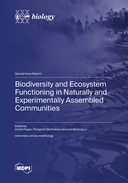Explore

Biodiversity and Ecosystem Functioning in Naturally and Experimentally Assembled Communities
0 Ungluers have
Faved this Work
Login to Fave
This reprint presents two reviews and thirteen research articles dealing with a broad range of biodiversity and ecosystem functioning (BEF) relationships. Each article provides in-depth discussion of the various aspects of BEF relationships in naturally and experimentally assembled communities. This reprint will help to substantially deepen our understanding of BEF interactions and elaborate biodiversity conservation in a changing world. Thus, this publication is not only of interest to scientists in the field, but also for students, university teachers, policymakers, and those who are interested in BEF in general.
This book is included in DOAB.
Why read this book? Have your say.
You must be logged in to comment.
Rights Information
Are you the author or publisher of this work? If so, you can claim it as yours by registering as an Unglue.it rights holder.Downloads
This work has been downloaded 105 times via unglue.it ebook links.
- 105 - pdf (CC BY) at Unglue.it.
Keywords
- 16S rRNA gene
- agroecosystem
- Ailuropoda melanoleuca
- anthropogenic disturbances
- aquatic insect
- arbuscular mycorrhizal fungi
- autotroph-herbivore interactions
- big data mining
- Biochemical engineering
- bioclimatology
- Biodiversity
- Biofilm
- Biogeography
- biomass allocation
- Biotechnology
- carbonic anhydrase
- cereal–legume
- Climate
- conservation policies
- core microbiome
- desalination
- determinism
- Diatoms
- edaphic variations
- elemental variability
- environmental gradients
- Erxianyan peatland
- extreme ecosystems
- feeding behaviour
- fire
- function prediction
- functional traits
- fungal diversity
- genetic diversification
- Greece
- habitat quality
- habitat selection
- halophytes
- Heavy metals
- horizontal gene transfer
- hydrothermal vents
- indica–japonica rice
- industrial pollution
- InVEST model
- macroalgae
- marine herbivores
- metal
- microbial community composition
- microbial diversity
- mobile genetic elements
- model simulations
- molecular fingerprint
- n/a
- natural hybridization
- Niba Mountain corridor
- nutrient accumulation
- nutrient acquisition
- Oryza sativa
- Paddy field
- phytogeographical units
- plant diversity loss
- plant nutrients
- plant–plant interaction
- principal component analysis
- randomness
- rare microbial taxa
- rice monoculture
- rice–fish co-culture
- Rivers
- saline flat regions
- saprotrophic fungi
- scaling exponent
- snub-nosed monkey
- soil multifunctionality
- soil organic carbon
- soil total nitrogen
- species conservation
- species mixtures
- Sphagnum palustre
- suitable habitat
- Technology, engineering, agriculture
- Technology: general issues
- Theory
- thermophilic microbiome
- Tulipa spp.
- village development
- wastewater treatment plant
- weed competition
Links
DOI: 10.3390/books978-3-0365-8099-9Editions

